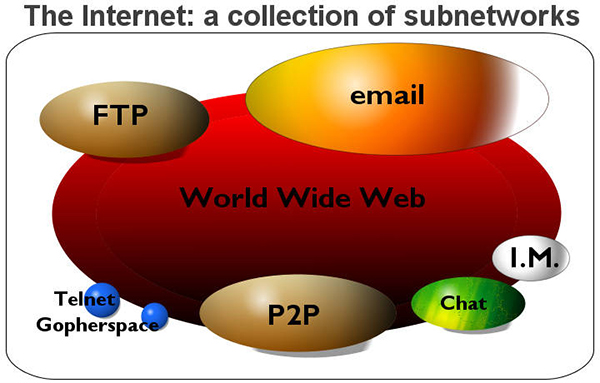 I was curious about this Gopher thing. I had heard of it before, but I don’t think I’ve heard of anyone actually using it, even back in the day. Here’s an image I used to use with classes when talking about the Web and the Internet:
I was curious about this Gopher thing. I had heard of it before, but I don’t think I’ve heard of anyone actually using it, even back in the day. Here’s an image I used to use with classes when talking about the Web and the Internet:
You can see the Gopherspace in there, partly on the web and partly not. I think that’s where I heard of Gopher. So I looked to see what i could find out.
There’s a Wikipedia page that goes into some detail about it. It basically sounds like browsing the Web in DOS through a command-line terminal, like the way they used to have to do things before GUIs. Of course, once people had graphical user interfaces, only hardcore geeks used command-line stuff. So Gopher never really caught on.
As an aside, DOS type programs do have their advantages. When I worked in publishing, the people on my crew who did typing and document mark-up all used an old 80s DOS program called PFS ProWrite, even as late as 2006. My boss tried to push MS Word, but Word hogs resources and slows down the computer, and every so-called “upgrade” just made it worse, whereas the DOS programs worked as fast as the keyboard operator could go. So Gopher would have been great for people with underpowered computers or people who weren’t interested in flashy animated advertisements.
I found a video from GeekBlogTV where a guy prattles on about the wonders of Gopher:
and another from C|Net, with an annoying commercial that’s nearly as long as the whole video, that talks about running Gopher on Firefox:
In Firefox, you go to Tools – Add-ons, search for Overbite and install OverbiteFF. When you restart the browser, you can browse Gopherspace. There’s not a lot there, but there probably wasn’t much there in 1991 either, compared to the web we’re used to.
One thing you will notice is that the URLs start with gopher:// instead of the usual HTTP. That’s because Gopher was a competing system to the hypertext transfer protocol. It’s not competitive these days, just different.
Web2Gopher is a good place to find out more. Another good thing to consult would be The Internet Gopher Protocol (a distributed document search and retrieval protocol) from the guys who made Gopher. That’s one of those primary source documents you can sometimes find connected to Wiki articles.
Gopher was an aspect of the Internet that I hadn’t given any real consideration before, so it was cool to find out a little about it. So I’ve got that going for me, which is nice.



KILL ALL THE GOPHERS!
Pingback: Archie, Veronica, and Other Old Gold Technologies | bavatuesdays
I ran a gopher server at Maricopa maybe in 1992-1993, it ran on a little Mac SE/30. I might have some files on an old floppy. It was a first step in hyperconnected resources. Before then, you could ftp to different servers and get files, but the idea of gopher was a bit web like in that you could connect your server to another easily.
FOund it, the server was at gopher://tapeats.mcli.dist.maricopa.edu/ and found a little article I wrote for out office “Tools for the Internet: Gopher” (I have been putting my old Maricopa content on my site since they dismantled my stuff)
http://mcli.cogdogblog.com/labyforum/Feb93/Feb93L7.html
It was more of a tree like/directory navigation structure. You would start at a gopher server, and traverse down directories, where you might get text files, images, or more directories. You could also make a folder also be a link to another gopher server, or a folder within another gopher server. I think you just made a directory structure on the server, and that became navigable, and there was some syntax for making something an alias to another server.
At the time we used a VAX for email, and there was a command to open a connection yo a gopher text console where you would arrow key up and down directories, and press return to select. There were graphic apps, TurboGopher was the Mac one (there is a screen shot in the article above).
As a precursor to the web it had that open attribute, that you could connect your gopher server to any other one. It was rather popular with libraries, but rather quickly supplanted when Mosaic came out.
Pingback: Old Gold Days at Maricopa - CogDogBlog